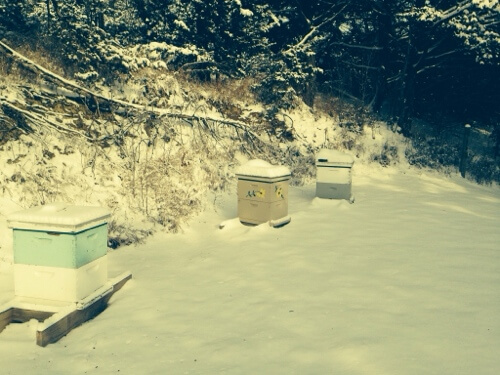
A lot of you have been curious about how the bees are fairing in the cold. And frankly, I am as well. When the temps fall into the single digits as they did last night, I find myself worrying about their health and wellbeing. Living in Kansas for some time now, we’ve become used to the ups and downs of temps and weather extremes. You know the old saying, if you don’t like the weather in Kansas, just wait fifteen minutes or so, it will change.
I am a nurturer by nature. I was a nurse for seventeen years and have kept horses professionally for some fifteen years as well as chickens. I blanket, provide good quality feed and hay and ensure heated water sourses. It seems my days are spent ensuring the animals are warm, safe and healthy throughout the cold winter. So, when it comes to bees, I must admit I was somewhat perplexed.
My first year as a backyard beekeeper was a steep learning curve. I went from knowing very little of the lifecycle of the apis melliferas (honeybee) to writing a blog focused on beekeeping. But, the one of the most important things I’ve learned, is preparation for wintering a hive begins well in advance. From the moment you pull your last fall honey super(mine was in September) you need to focus your time and energy in strengthening your hive for the long winter ahead. In the bee world, strength in numbers is not just a saying, it’s survival.
Extracting fall honey is exciting and rewarding but what about the bees? Bees do not hibernate, nor do they sleep. In order to survive the winter they must have a food source. The fall can be lovely in Kansas with a number of late blooming plants but as the days shorten, the bees natural food sources disappear quickly. The queen bee’s internal clock slows down as does the number of hatching brood. Meanwhile the worker bees find foraging more difficult all the while still following the age old instinct to produce and store honey. Here in the midwest its recomended that bees keep two full brood boxes full of honey for their winter stores which equates to 50-100 pounds per hive body. Remember bees must maintain a hive temp of 96 degrees. They do so by fanning their collective wings to either cool or heat the hive. As you can imagine there is a lot of fanning going on about now with the temps in the single digits.
As I mentioned before preparation for the winter is started as soon as the honey supers are pulled. One of my first tasks was to treat my hives for mites to ensure a healthy, strong hive going into the winter. All hives will have mites to some degree. Luckily my hives had miminal mite counts but the varroa mite is one of the many problems honeybees face in their race for survival. There are a number of commercial products on the market today. I choose Apivar, which is a treated plastic strip installed between the frames and left for 30 days. (2 strips per brood chamber)
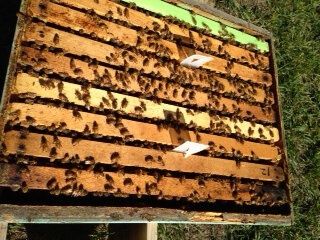
The next step was to begin a fall feeding program. I made a 2:1 simple sugar syrup and placed the liquid in a top hive feeder. The bees can come and go at will and of course so can lots of other critters. Check out my post; The Hunt for Yellow October, dealing with ongoing battle with yellow jackets. I used white granulated sugar and added a commercial feeding stimulant from Dadant called Honey Bee Healthy which is a concentration of spearmint and lemongrass essential oils. Two of my three hives seemed to like their feed but the third, not so much. Of course the yellow jackets were thrilled. Then came the decision as whether to treat for nosema with Fumagilin-B. Nosema is a virus that can spread rapidly and decimate a hive. A normal healthy hive can resist nosema and the medication itself is placed in the syrup in the late fall to prevent an outbreak. My hives appeared to be thriving and I made the tactical decision not to treat with furthur chemicals this year. A decision I may come to regret in the Spring. By late fall, one of my strongest hives was not taking the syrup very well and seemed light on winter stores. They became known to me as my Failure to Thrive hive and their numbers are significantly diminished. But by the time I realized this, temps were dropping below freezing and the top feeders were no longer an option.
So fast forward to mid winter. As I stated, we’ve had an extremely cold winter so far with only a few days here and there above 50 degrees, the minimum temperature for bees to make their cleansing flights. The hive’s honey stores will be used up rapidly at this rate. Since syrup is no longer an option, making a candy board was my next choice.
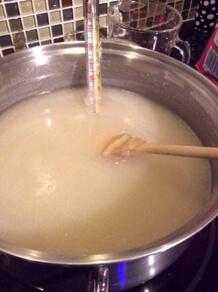
We start again with white granulated sugar using 5 pounds more or less to two cups water. Bring to the soft ball stage or 245 degrees when the syrup takes on a clear yellowish color, remove from heat but continue to stir. As is begins to thicken, pour onto prepared sheets. Cookie sheets lined with wax paper work well and fit my feeder frame easily. I purchased pollen patties through Dadant Beekeeping supplies in the fall and placed them in the middle of the candy board.
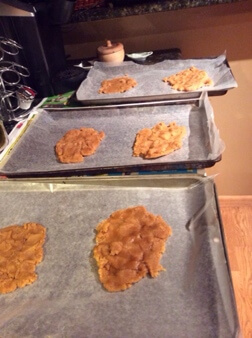
Allow the candy to harden

And place on your feeder frame

Of course the bees will be drawn to the pollen patties, so replace as needed, weather permitting.
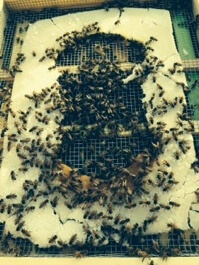
A few other housekeeping rules for wintering bees is a must in the Midwest:
Install entrance reducers and bottom boards if used. Before installing the entrance reducer, check brood chambers for any critters that might have taken up residence in the warm honey filled hive, like mice.
Place hives in a natural windbreak or provide a windbreak via tarps or haybales and face the entrances to catch the morning sun. My hives have a natural bern behind them and face in a southeast direction.
Repair holes or cracks in the fall but still allow for proper ventilation. Moisture is by far the worst enemy to the bee hive.
I make frequent checks on my hives ensuring the lids are properly weighted down and snow is brushed off the hive entrances and tops. I want to keep melted snow from pooling anywhere on the hives. Hives are tipped forward slightly to allow for drainage.
On warm days, check that bees are out flying and refill feeders as necessary.
Because of the extreme temp variations, we don’t wrap hives in Kansas to prevent moisture buildup.
Prep for spring by gathering and repairing your supplies, retreating for mites or nosema before adding honey supers. Ensure the health and prescence of a laying queen and if not, ordering queens or bee packages.
You will be pleasantly surprised at how quickly the bees will build up in the Spring so above all be prepared.
But for now, I still continue to worry about my bees and hope my fall prep and winter diligence will pay off at the first sign of Spring.







